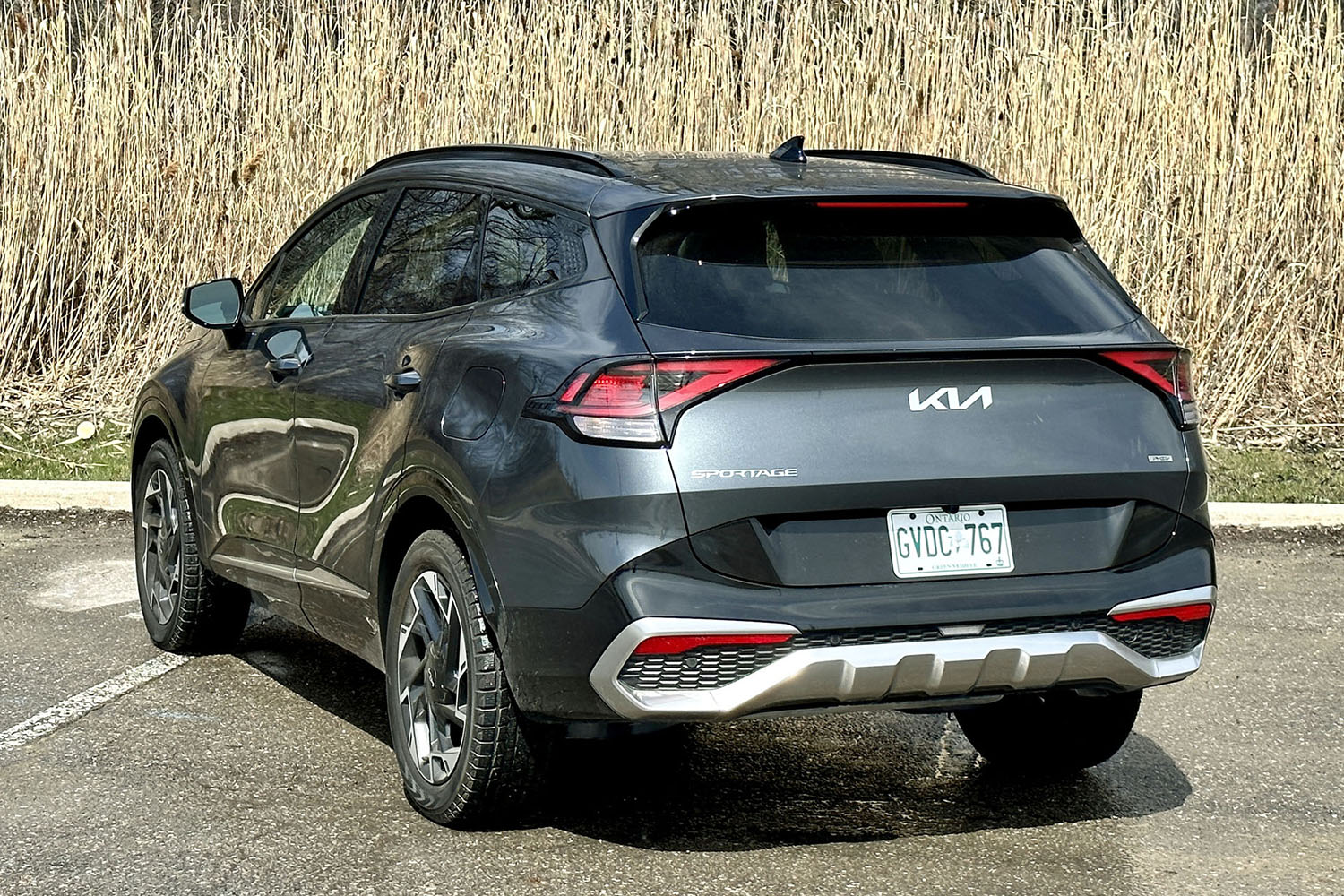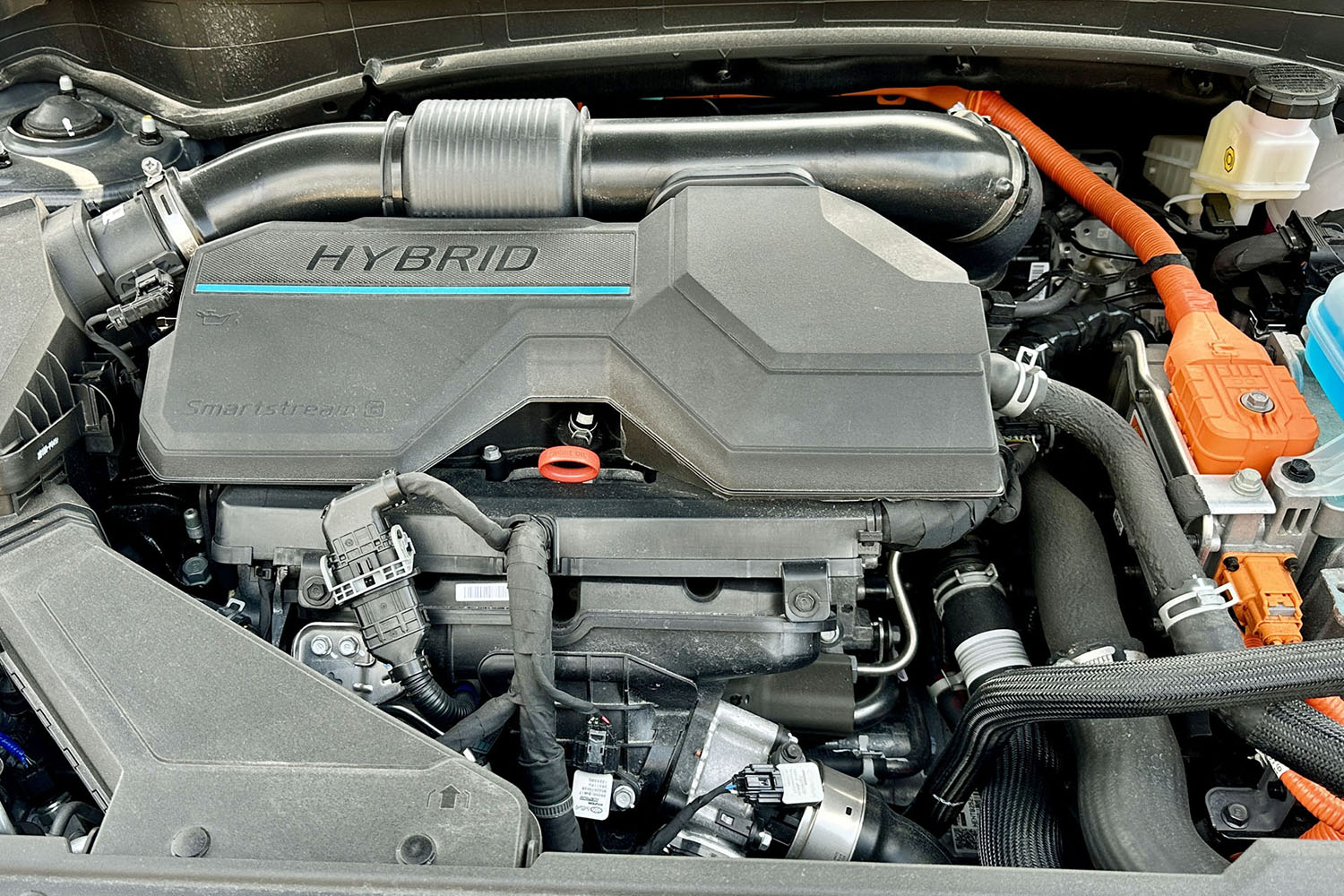When Kia arrived in Canada in 1999, it did so with the Sephia and original Sportage. This body-on-frame SUV was marked by its crude execution and dreadful performance. The good news is subsequent generations saw Kia’s compact crossover grow in size, stature and, more importantly, quality. Now in its fifth-generation, the Sportage has come of age and is offered three ways — along with the regular gas-powered model there are now two hybrids, including a plug-in.

2023 Kia Sportage SX PHEV / Graeme Fletcher, The Charge
Both the hybrid (HEV) and plug-in hybrid (PHEV) models use the same 177 horsepower, 1.6-litre turbo-four, an electric motor and a battery. The difference between the two hybrid systems basically boils down to the size of the battery and the horsepower developed by the electric motor. The HEV uses a 1.49 kilowatt-hour battery and an electric motor that twists out 59 hp and 195 pound-feet of torque. This gives it a net system output of 227 hp and 258 lb-ft of torque.
Move up to the PHEV and the battery grows to 13.8 kWh with the electric motor now making 90 hp and 224 lb-ft of torque. This ups the net system output to 261 hp and 258 lb-ft of torque, which gives it the wherewithal to run from rest to 100 km/h in 7.6 seconds while posting an official average fuel economy of 6.7 L/100 km. Both are solid numbers.

2023 Kia Sportage SX PHEV / Graeme Fletcher, The Charge
However, when the PHEV’s battery is fully charged, its ability to deliver up to 55 kilometres of electric-only driving drops the average consumption to 2.8 Le/100 km. The electric-only range also means the Sportage PHEV qualifies for the full $5,000 Federal incentive — think of this as the money needed to upgrade from the Sportage SX HEV to the SX PHEV for $800 (as-tested price for this test vehicle is $49,245). Charging the PHEV’s battery from 15 to 100 per cent takes two hours when plugged into a Level 2 charger. However, plug it into a 110-volt outlet and it requires a lengthy 11 hours and 10 minutes to do the same thing.
Sportage EX PHEV base Price/As tested SX PHEV: $45,595/$49,245

2023 Kia Sportage SX PHEV / Graeme Fletcher, The Charge
There are different hybrid modes — EV (electric only), Hybrid and Automatic. The latter decides how to best use the engine and electric motor, although what separates it from Hybrid mode is not exactly clear. As such, use Hybrid as the set-and-forget position. In this mode, the system switches between the different power sources in a seamless, responsive manner without the driver having to think about it.
What’s missing is a battery save function. It would allow the driver to save the battery’s energy for another time. The engine is at its most efficient on the highway and at its least efficient in the city, so why not allow the driver to keep the battery power for the city portion of the drive?

2023 Kia Sportage SX PHEV / Graeme Fletcher, The Charge
There are also Eco, Sport and Smart driving modes. Eco tends to blunt the performance because of its quest for the best fuel economy. Sport puts a little more weight in the steering, which is a good thing, and it sharpens the throttle response nicely. It’s best used beyond city limits where you can let the Sportage run. Smart mode represents the middle ground, as it picks between Eco and Sport according to the driving situation. The issue is it feels a little lazy at times and a little too eager at others. Sportage needs a Normal or Comfort mode and the consistency either would bring to the drive.

2023 Kia Sportage SX PHEV / Graeme Fletcher, The Charge
The PHEV works with a six-speed automatic transmission and a good all-wheel-drive (AWD) system. The transmission shifts smoothly and it’s quick to drop a cog or two when the driver demands power. It also has the knack of being in the right gear at any given time, which complements the AWD system. Here, an electro-hydraulic coupling actively distributes the drive torque between the front and rear axles. In short, the setup is responsive and delivers reliable traction during acceleration and when cornering. In inclement weather, the initial pull-away is crisp and devoid of wasted wheelspin. It is one of the better systems. Finally, it works with a Terrain management system with a useful snow mode along with mud and sand. The last two are destined to be redundant.

2023 Kia Sportage SX PHEV / Graeme Fletcher, The Charge
The Sportage’s N3 platform, which it shares with the Sorento, is stiff and provides a solid base of operations for the front struts and multilink rear suspension. It is a balanced set up. On the highway the ride is quiet and refined, yet through a hard and fast corner the suspension effectively dials out unwanted body roll. The steering also delivers decent feedback with the on-centre feel being well defined.
The Sportage’s distinctive exterior style flows neatly into a cabin with premium materials and a balanced blend of functionality and comfort. For example, the power, heated/cooled, front seats are wrapped in a synthetic leather that is, for once, not as tacky as it sounds.

2023 Kia Sportage SX PHEV / Graeme Fletcher, The Charge
The SX model also arrives with a driver-focused cockpit. The attractive visual presentation is centred around a pair of 12.3-inch screens housed under a single pane of glass. The effect gives the impression that it’s one large display. The instrumentation is clean and uncluttered, as is the infotainment system. It supports Apple CarPlay and Android Auto along with navigation and a good Harman Kardon sound system. Below the multimedia screen is a row of touchpoints that can be toggled between the controls for the infotainment system and the heating/ventilation functions. It works, but the touchpoint used to switch the controls between functions could do with being larger.
Move rearward and there is plenty of headroom and 1,050-millimetres of legroom, which is enough for a pair of adults to relax comfortably in the heated outboard seats. Likewise, the cargo space is generous with 1,121 litres the seats up and 2,087L with them folded down.

2023 Kia Sportage SX PHEV / Graeme Fletcher, The Charge
The 2023 Kia Sportage SX PHEV is a good all-rounder. It balances the desire for performance with the need to reduce operating costs. It also brings a comfortably quiet highway ride, a nimble backroads experience and a cabin that rivals some near-luxury crossovers for quality and the lengthy list of amenities. Minor drive mode nits aside, it comes together to make it a hot contender in a very tough segment.






